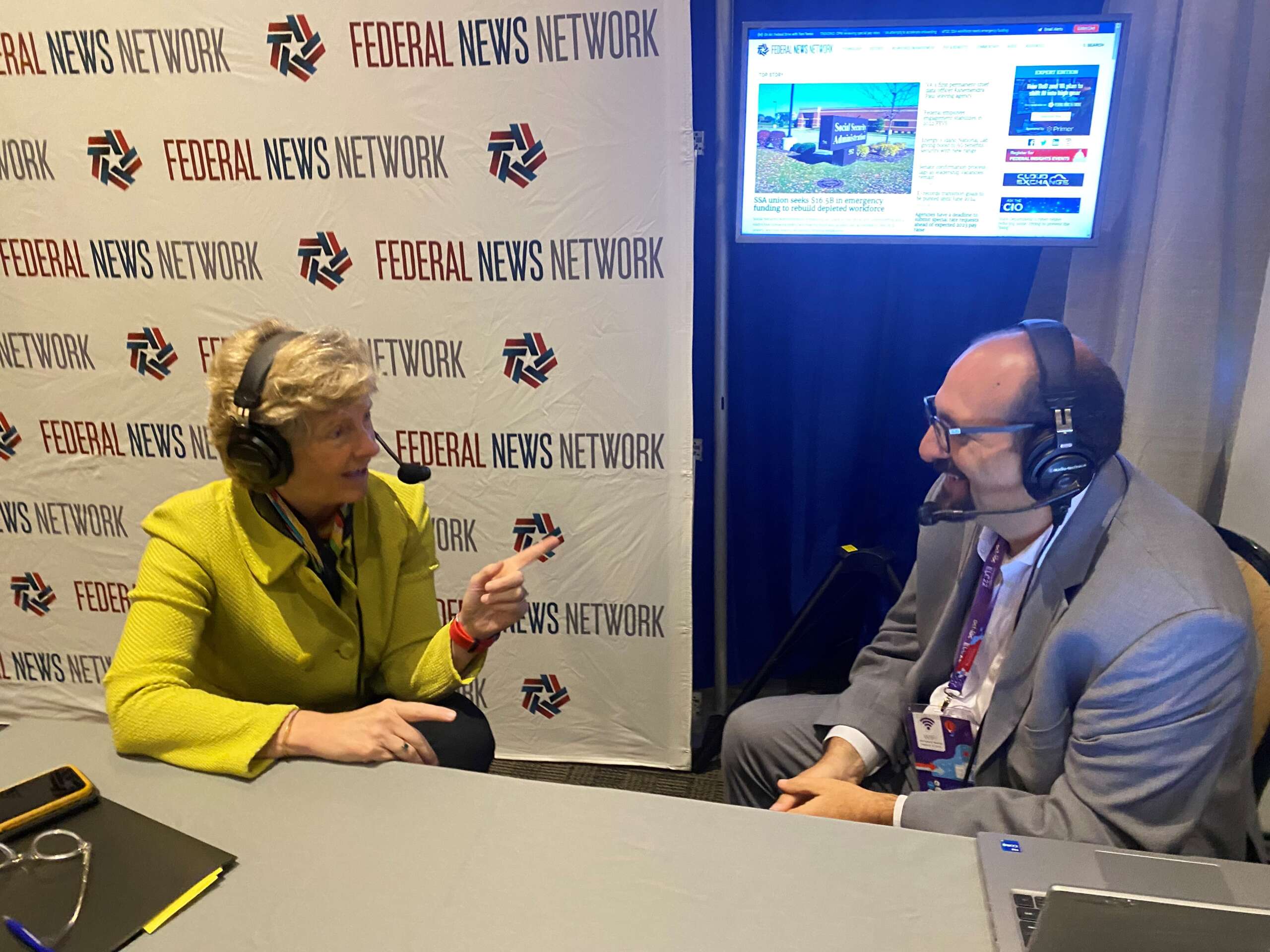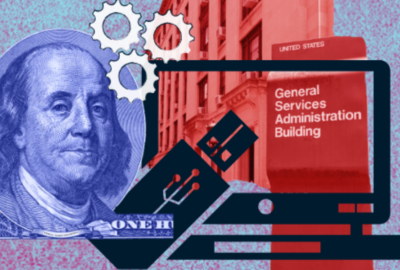Carnahan accomplished much of what she came to GSA to do
Robin Carnahan, the out-going GSA administrator, said the federal footprint shrunk by 11 million square feet and saved $2 billion in 2024 alone.
Despite four years of trying, Congress didn’t budge on letting the General Services Administration use the full amount of money collected in the Federal Building Fund.
Of all the things Robin Carnahan, GSA’s out-going administrator, accomplished over the last three-plus years, getting Congress to change its mind wasn’t one of them.
But Carnahan said that lack of cooperation by lawmakers didn’t stop GSA from improving federal buildings and disposing of those the government doesn’t need any more.

“We’ve done a lot to shrink that over the years, but there’s a lot, lot more that can be done,” Carnahan said in an exclusive “exit” interview with Federal News Network. “We’ve done a portfolio review. We think we could shrink our portfolio by 30%, saving $60 billion over the next 10 years. But that’s not going to happen automatically. It’s going to require a lot of work to make sure that we have access to the predictable funding that’s necessary to do this kind of infrastructure work.”
She added GSA got rid of over 11 million square feet and saved almost $2 billion in 2024 alone.
“We are making progress on this front, but we can make a lot more if we had access to this [Federal Buildings Fund],” Carnahan said. “What we have seen with annual budget cycles is that they sometimes kick the can down the road on things. When we can’t do a project or maintain a building, it’s not like those costs go away, those deferred maintenance costs just get bigger. So every time we send a prospectus up, that that doesn’t get done and gets kicked into the next year, it can be millions of dollars extra to get that project done. The Federal Buildings Fund was originally intended to give GSA the flexibility it needed to do planning to have these projects done in ways that are cost effective. That’s the case I continue to make. I think people understand it on the hill, but we’re living in a world of constrained budgets and so we just need to make some choices.”
In its fiscal 2025 budget request, GSA asked Congress to change the budgetary treatment of the rent revenues deposited in the FBF and the associated legislative scoring guidelines.
“Adopting similar scoring treatment for the FBF will help ensure that GSA is provided full access to the annual revenues and collections deposited in the FBF,” GSA wrote in its budget justification. “Agencies make rental payments to GSA with the expectation that such funds will be used to properly maintain the facilities they occupy, which GSA has been unable to do over the past decade due to a lack of new obligation authority appropriated commensurate with the annual revenues and collections deposited in the FBF. Modernizing federally owned facilities will enable GSA to consolidate and reduce the federal government’s heavy reliance on space leased from private lessors, which will provide cost avoidance many times over.”
GSA shrunk the federal footprint
Carnahan said without access to the money, the concept of investing a little to save a lot of money is much more difficult.
“I’d call on the next team to continue to have conversations about this because I think we all agree we ought to have the appropriate size real estate portfolio and the assets we don’t need we should get rid of,” she said. “They should be useful in their communities. But right now, we are hamstrung doing that because of no access to the federal buildings fund. So this is a decision for the next Congress and the next administration.”
Even without access to the funds, GSA used $975 million from the Inflation Reduction Act to upgrade federal buildings across the country with emerging and sustainable technologies.
In a Jan. 15 blog post, GSA says the IRA funds for emerging and sustainable technologies will impact about 40 million square feet — about 20% — of GSA’s federal building portfolio and avoid $467 million in energy costs for American taxpayers over the next two decades. Through these projects, 28 buildings will achieve net zero emissions and 100 more buildings will become all-electric.
The big question GSA now faces is whether federal buildings are ready for a potential influx of employees returning to the office full time.
Carnahan said while she can’t speak to the next administration, she is confidence GSA will be able to successfully deal with any requirements.
“Frankly, like that whole issue about the Federal Buildings Fund and lack of maintenance and lack of upgrades matters. In the olden days, everybody had their own offices. If you’re going to have modern office space, you’ve need to reconfigure all of that. Some agencies have done that. Some agencies have not,” she said. “So I really think this is going to be a case-by-case basis, and there will be a lot of activity in this, this realm, I’m sure.”
TMF proves its value
Aside from federal buildings, Carnahan said she’s most proud of the success GSA had in improving delivery of services across the government.
She famously said she wanted to “fix the damn websites,” when she first took the helm of GSA.
“I came here to do that. I think that we’ve made progress. But look, the work is never done. There’s a huge modernization effort that’s needed across government. That’s why, by the way, the Technology Modernization Fund, which you did not mention, but I always do, is the conduit for actually modernizing government,” she said. “The way the budget process works on Capitol Hill is too slow and too bifurcated and siloed to be able to get good results. Too much of what happens there is maintaining old legacy systems., and to modernize, you need to be able to move faster and you need to have people who understand technology be involved in that process. That’s what the TMF is. So yeah, these are, these are issues that I think that we’ve spent a lot of time on, and I don’t think they’re going to go away. These are things that just make good sense for better government and saving money.”
During the Biden administration, the TMF received $1 billion from the American Rescue Plan Act, which the board used to invest in 63 projects across 34 agencies.
In 2024 alone, the TMF board loaned out $240 million to across 16 projects.
Carnahan said the investments that received TMF funding are paying off in better services and/or more secure applications.
But she also recognized the frustration over Congress zeroing out the TMF in 2024 and showing tepid support for the program outside of the ARPA funding.
“I just think it’s a matter of the proof is in the pudding, and at some point, folks, if they actually want to make improvements in modernized government, they’re going to see that this is this is an entity that knows how to get it done, and they’re going to fund it,” Carnahan said. “But in terms of how government works, it is still relatively new and I think what’s been important is that we prove out the case that it’s been effective.”
Advice for next GSA leader
As for the next GSA administrator, Carnahan said the continued push to change the Federal Buildings Fund and to support the TMF would be two continuing priorities.
She also said the next administrator should lean on the experts across GSA and continue to empower the teams to carry out the agency’s missions.
“You’ve heard me talk about government is a service delivery business. People expect it to work well and to get value out of what they’re dealing with in government. I came to government from that perspective. So for me, GSA is the natural place to do that because we’re the operating arm of the government,” she said. “We were set up by [President] Harry Truman 75 years ago to make government work better and to save money doing it. That’s our mission today, and that’s what we’ve been focused on for the last three plus years. I feel really great about the work that we’ve done. We’ve used our buying power for the good. We can help move markets. We can help focus on making it easier for small businesses to work with the government. We can make it so that we can have both environmentally responsible products and good prices at the same time. We can make it so that we protect people’s privacy. So there are lots of things we can do there. We’ve also really focused on customers. How do we put ourselves in our customers shoes and make sure the experience that they have operating dealing with GSA is good. Our customer satisfaction scores are the highest they’ve ever been, and we’ve really focused on empowering our people to do their best work wherever that is in the country, because we have folks everywhere, 75% of our people are outside of Washington.”
Copyright © 2025 Federal News Network. All rights reserved. This website is not intended for users located within the European Economic Area.
Jason Miller is executive editor of Federal News Network and directs news coverage on the people, policy and programs of the federal government.
Follow @jmillerWFED







